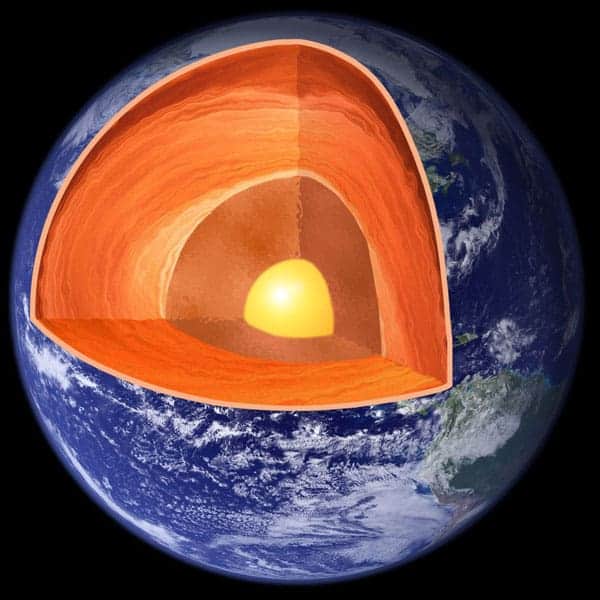
About 50% of the heat given off by the Earth is generated by the radioactive decay of elements such as uranium and thorium, and their decay products. That is the conclusion of an international team of physicists that has used the KamLAND detector in Japan to measure the flux of antineutrinos emanating from deep within the Earth. The result, which agrees with previous calculations of the radioactive heating, should help physicists to improve models of how heat is generated in the Earth.
Geophysicists believe that heat flows from Earth’s interior into space at a rate of about 44 × 1012 W (TW). What is not clear, however, is how much of this heat is primordial – left over from the formation of the Earth – and how much is generated by radioactive decay.
The most popular model of radioactive heating is based on the bulk silicate Earth (BSE) model, which assumes that radioactive materials, such as uranium and thorium, are found in the Earth’s lithosphere and mantle – but not in its iron core. The BSE also says that the abundance of radioactive material can be estimated by studying igneous rocks formed on Earth, as well as the composition of meteorites.
As a result of this model, scientists believe that about 20 TW is generated by radioactive decay – 8 TW from the uranium-238 decay chain; 8 TW from the thorium-232 decay chain and the final 4 TW from potassium-40. Fortunately, these decay chains also produce anti-electron-neutrinos, which travel easily through the Earth and can be detected, thereby giving physicists a way to measure the decay rates and ultimately the heat produced deep underground.
Decay and measure
In 2005 researchers at KamLAND announced that they had detected about 22 such “geoneutrinos”, while last year scientists at the Borexino experiment in Italy said they had detected 10. Now, the KamLAND team has bagged a total of 111 of these tiny almost massless particles. The combined results have allowed the KamLAND team to conclude that the heat flux due to the uranium and thorium decay chains is about 20 TW with an uncertainty of about 8 TW. While the KamLAND experiment cannot detect the lower-energy antineutrinos from potassium-40 decay, the researchers believe that the value predicted by the BSE model of 4 TW is correct.
Although 20 TW from uranium and thorium is more than the 16 TW predicted by the BSE model, it is still within the experimental uncertainty – and is much less than the total flux of 44 TW. “One thing we can say with near certainty is that radioactive decay alone is not enough to account for Earth’s heat energy,” says KamLAND collaborator Stuart Freedman of the Lawrence Berkeley Laboratory in California. “Whether the rest is primordial heat or comes from another source is an unanswered question.”
One possibility that has been mooted in the past is that a natural nuclear reactor exists deep within the Earth and produces heat via a fission chain reaction. Data from KamLAND and Borexino do not rule out the possibility of such an underground reactor but place upper limits on how much heat could be produced by the reactor deep, if it exists. KamLAND sets this limit at about 5 TW, while Borexino puts it at about 3 TW.
Oil-filled balloon
The KamLAND detector is a huge balloon filled with 1000 tonnes of mineral oil that is monitored by more than 1800 photomultiplier tubes. It is located deep underground in a Japanese mine to shield the detector from cosmic rays.
Very occasionally an antineutrino will react with a proton in the oil to create a neutron and a positron. The positron travels a short distance through the oil, giving off a flash of light as it ionizes oil molecules. The positron then annihilates with an electron to create two gamma-ray photons. These two processes happen very quickly and the light can be detected by the photomultiplier tubes. In addition, the energy of the antineutrino can be estimated from the amount of light given off during ionization.
A few hundred milliseconds later, the neutron is captured by a proton to form a deuteron. This results in the emission of a gamma ray, which can also be detected by the photomultiplier tubes. By looking for signals in the photomultiplier tubes that are separated by the appropriate amount of time, KamLAND can discriminate between extremely rare antineutrino events and the much more common signals due to background radiation.
The work is described in Nature Geoscience 10.1038/ngeo1205.



